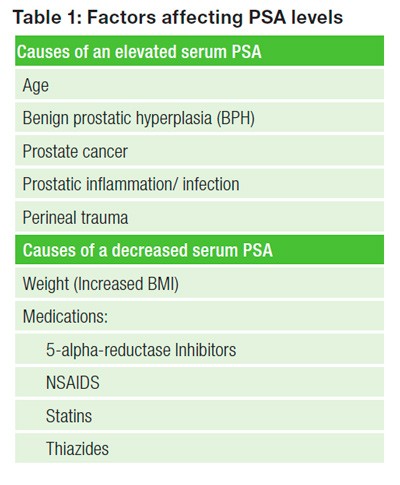 Prostate cancer is one of the most common cancers diagnosed in Australia. It is estimated that just over 16,000 new cases will be diagnosed this year (23 % of all new cancers).
Prostate cancer is one of the most common cancers diagnosed in Australia. It is estimated that just over 16,000 new cases will be diagnosed this year (23 % of all new cancers).
Even though the five-year survival rate is > 95%, prostate cancer mortality (12.7 % of all cancer deaths) is expected to be the third highest after lung and colorectal cancer this year. (Prostate cancer statistics | Prostate Cancer, 2017)
Serum prostate-specific antigen (PSA) is an effective marker of prostate cancer; its value as a screening tool is less certain. (Prcic, Begic, and Hiros, 2016)
Table 3: Sensitivity & Specificity of PSA (Total)
| Range (ug/L) | Sensitivity | Specificity | Positive Predictive Value | Negative Predictive Value |
| <2 | 25% | 61.3% | 4.8% | 91.2% |
| 2-4 | 29.1% | 59.4% | 19.3% | 71.5% |
| 4-10 | 62.7% | 45.3% | 40.9% | 66.7% |
| 2-10 | 81.9% | 16.8% | 37.4% | 60.5% |
| 10-20 | 8.4% | 94.2% | 46.7% | 62.9% |
| >20 | 4.8% | 97.8% | 57.1% | 62.9% |
Various factors other than prostate cancer may cause abnormal levels of PSA, which may impact on patient care and should be considered when interpreting PSA results (see Table 1).
One of the most important factors seldom considered is the differences seen among PSA methods performed on different analysers.
A major reason is the lack of standardisation amongst the various manufacturers of PSA reagents. There are numerous assays for prostate-specific antigen detection with well-documented variability in measurement. Despite international efforts to standardise the assays across manufacturers, mainly through creating a common reference material, this has not eliminated between-assay differences. While there have been improvements, results from various assays remain non-comparable primarily due to use of different antibodies and calibrators. This applies to many other analytes and underpins why serial testing should always be done using the same assay to minimise the effect of result differences on patient monitoring.
Notwithstanding the variability seen between manufacturers, random variation will always form part of serial testing results. Both biological and analytical variability play a significant role when interpreting serial results.

Various factors other than prostate cancer may cause abnormal levels of PSA, which may impact on patient care and should be considered when interpreting PSA results (see Table 1).
One of the most important factors seldom considered is the differences seen among PSA methods performed on different analysers.
A major reason is the lack of standardisation amongst the various manufacturers of PSA reagents. There are numerous assays for prostate-specific antigen detection with well-documented variability in measurement. Despite international efforts to standardise the assays across manufacturers, mainly through creating a common reference material, this has not eliminated between-assay differences. While there have been improvements, results from various assays remain non-comparable primarily due to use of different antibodies and calibrators. This applies to many other analytes and underpins why serial testing should always be done using the same assay to minimise the effect of result differences on patient monitoring.
Notwithstanding the variability seen between manufacturers, random variation will always form part of serial testing results. Both biological and analytical variability play a significant role when interpreting serial results.
Take Home Points
- Prostate cancer is one of the most common cancers diagnosed today.
- Serial PSA testing should be performed using the same analysing platform.
- Always consider secondary causes of elevated PSA level.
- Interpret using age specific ranges
- Appropriate use of free to total-PSA ratio are indicated for PSA levels above age-related- median to <10 ug/L
- The usefulness of PHI is still to be confirmed
Disclaimer: Please note, this website is not a substitute for independent professional advice. Nothing contained in this website is intended to be used as medical advice and it is not intended to be used to diagnose, treat, cure or prevent any disease, nor should it be used for therapeutic purposes or as a substitute for your own health professional’s advice. Opinions expressed at this website do not necessarily reflect those of Medical Forum magazine. Medical Forum makes no warranties about any of the content of this website, nor any representations or undertakings about any content of any other website referred to, or accessible, through this website.

